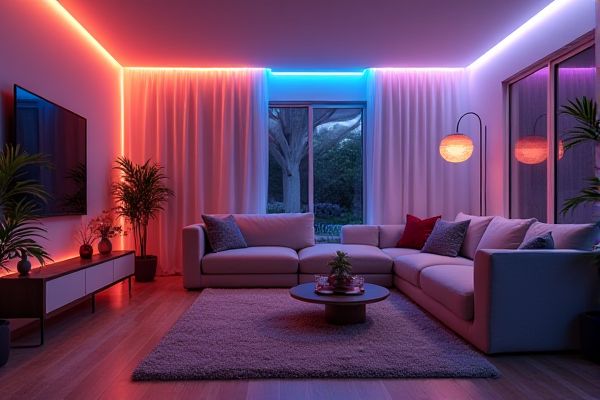
LED strip lighting offers greater brightness, flexibility, and energy efficiency compared to rope lighting, which tends to be more diffuse and decorative. Discover how choosing the right option can enhance Your space by reading the full article.
Table of Comparison
| Feature | LED Strip Lighting | Rope Lighting |
|---|---|---|
| Light Source | Individual LEDs mounted on a flexible circuit board | Incandescent or LED bulbs encased in flexible tubing |
| Brightness | Higher lumen output per foot | Lower lumen output per foot |
| Flexibility | Highly flexible, suitable for complex shapes | Moderately flexible, best for gentle curves |
| Energy Efficiency | Ultra energy-efficient, low power consumption | Less energy-efficient especially incandescent versions |
| Durability | Long lifespan (up to 50,000 hours), resistant to heat | Lower lifespan, incandescent versions prone to heat damage |
| Color Options | Wide range of colors and RGB options | Limited color selection, typically single-color or warm white |
| Installation | Adhesive backing, cuttable at specified points | No cutting, sections connected end-to-end |
| Cost | Higher initial cost, better long-term value | Lower initial cost, higher operational cost |
| Use Cases | Accent lighting, backlighting, architectural, commercial | Decorative, holiday lighting, outdoor outlining |
Introduction to LED Strip Lighting and Rope Lighting
LED strip lighting offers flexible, adhesive-backed circuit boards embedded with surface-mounted LEDs, providing customizable brightness and color options ideal for accent lighting and creative designs. Rope lighting consists of small bulbs encased in a flexible plastic tube, delivering continuous, uniform illumination typically used for outlining or decorative purposes. Both solutions vary in energy efficiency, durability, and installation ease, making them suitable for different lighting projects.
Key Differences Between LED Strip and Rope Lights
LED strip lighting features flexible, thin circuit boards with closely spaced LEDs, offering precise brightness control and color options, while rope lighting encases bulbs in a thicker, durable plastic tubing, providing a softer, diffused glow. LED strips are ideal for detailed accent lighting and customizable designs, whereas rope lights excel in outdoor use and decorative border illumination due to their weather resistance. Your choice depends on whether you prioritize sleek design versatility or durability for exterior environments.
Brightness and Light Output Comparison
LED strip lighting offers superior brightness and higher luminous efficiency compared to rope lighting, making it ideal for tasks requiring focused illumination. Rope lighting typically emits a softer, diffused glow due to its enclosed bulbs, resulting in lower light output suitable for ambient or decorative purposes. Your choice should consider the brightness level needed, with LED strips providing more intense and consistent light output than rope lights.
Flexibility and Installation Ease
LED strip lighting offers superior flexibility with its thin, bendable design allowing easy installation on curved or irregular surfaces, making it ideal for intricate lighting projects. Rope lighting, encased in a thicker, rigid tubing, provides less flexibility but offers straightforward installation along straight edges or outdoor spaces. Both options feature adhesive backings or mounting clips, but LED strips require careful handling to avoid damaging the delicate circuitry.
Energy Efficiency and Power Consumption
LED strip lighting offers superior energy efficiency compared to traditional rope lighting, consuming significantly less power while providing brighter and more consistent illumination. LED strips typically use about 4-5 watts per meter, whereas rope lighting can consume up to 8-10 watts per meter, making LEDs more cost-effective for long-term use. The advanced technology in LED chips ensures minimal heat generation and reduced energy wastage, enhancing overall power consumption efficiency.
Design Options and Aesthetic Appeal
LED strip lighting offers versatile design options with flexible, thin strips that can be easily cut and shaped to fit intricate spaces, allowing for precise accent lighting and vibrant color effects. Rope lighting, enclosed in a cylindrical plastic tube, provides a softer, diffused glow ideal for creating a continuous, uniform light along edges or pathways, enhancing ambient atmosphere. Choosing between them impacts Your aesthetic appeal by balancing the sleek, modern look of LED strips against the classic, subtle illumination of rope lighting.
Durability and Lifespan
LED strip lighting offers superior durability and a longer lifespan compared to traditional rope lighting, often lasting up to 50,000 hours due to advanced semiconductor technology. Rope lighting, typically encased in flexible PVC tubing, is more prone to wear and damage from bending and environmental exposure, resulting in shorter functional life. For your projects requiring longevity and resilience, LED strip lighting provides a more reliable and maintenance-free solution.
Indoor vs Outdoor Use Cases
LED strip lighting offers superior versatility for indoor use, providing customizable brightness and color options ideal for accentuating home decor, under-cabinet lighting, or entertainment areas. Rope lighting, with its durable PVC casing and gentle diffuse glow, excels in outdoor settings, resisting moisture and harsh weather, making it perfect for garden pathways, patios, and outdoor events. Choosing the right lighting depends on your specific environment and ambiance needs, ensuring durability and aesthetic appeal in both indoor and outdoor applications.
Cost Analysis and Budget Considerations
LED strip lighting typically offers a higher upfront cost compared to rope lighting but provides greater energy efficiency and longer lifespan, resulting in lower overall operating expenses. Rope lighting tends to be more affordable initially but may require more frequent replacements and consumes more power, increasing long-term costs. Your budget should prioritize LED strip lighting if you aim for cost savings over time, while rope lighting suits short-term or low-budget projects.
Choosing the Right Lighting: Which is Best for Your Needs?
LED strip lighting offers greater flexibility, higher brightness levels, and energy efficiency, making it ideal for task lighting and accenting intricate spaces. Rope lighting provides a softer, diffused glow and is more suitable for ambient lighting in outdoor or decorative applications due to its durable, weather-resistant casing. Selecting the right option depends on the desired intensity, installation environment, and design goals.
 homyna.com
homyna.com